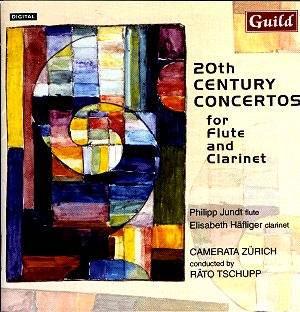The most remarkable feature about Haller’s Double
Concerto is its quite undogmatic use of dodecaphony. The composer,
who studied with Volkmar Andreae and Nadia Boulanger and who attended
Hindemith’s lectures at Zürich University in the 1950s, actually
seems nearer to the latter’s Neo-classicism than to Schönberg’s
dodecaphony. Dodecaphony provided Haller with a frame in which his tightly
argued music may develop in a coherent way without renouncing any of
its basic characteristics. These include formal clarity and concision,
qualities obviously learned from Nadia Boulanger, as well as some unproblematic
playfulness. As a whole, Haller’s Double Concerto is a
sincere, accessible and attractive work of great charm.
Vogel is still a much underrated composer who developed
his own brand of twelve-tone writing in a handful of substantial, though
often unusual works, that have still to be given their due. The present
recording of his Concertino for Flute, completed as late
as 1979 though it is listed as VWV 15 in the composer’s catalogue, might
well kindle some new interest for Vogel’s music. The Concertino is a
deeply serious, more austere piece of music in which formal rigour successfully
combines with direct expression within a concise single movement structure.
A most welcome discovery.
Robert Blum too was a pupil of Volkmar Andreae in Zürich
and a fellow student of Vogel and Weill at the Prussian Academy of the
Arts in Berlin. The composer describes the three sections of his Concertino
for Clarinet as short fantasies. The dark-hued, nervous introduction
of the first section clearly sets the scene for what is to follow. Blum’s
Concertino is another serious, sincere piece of music in an idiom slightly
more advanced than any of the other pieces recorded here. Quarter-tones
are called forth in the slow central section which creates some uneasy
feeling quickly dispelled in the last energetic section. Another worthy
addition to the repertoire.
Hans Schaeuble’s Concertino for Flute Op.47,
completed in 1959 and regularly revised later, is rather a suite of
short character pieces playing without break. On the whole, light-hearted
characterised by clarity of form and thought as well as light textures
prevail in this attractive and quite accessible neo-classical work.
It definitely deserves more than the occasional outing.
This well-planned, beautifully played and nicely recorded
selection of some little-known and unfamiliar works was Räto Tschupp’s
last recording. This release pays a deserved tribute to this fine musician
in the best possible way. It is well worth having for the quality of
the playing and the quality of the works. A last grumble, though: the
playing time is a bit on the short side.
Hubert Culot


